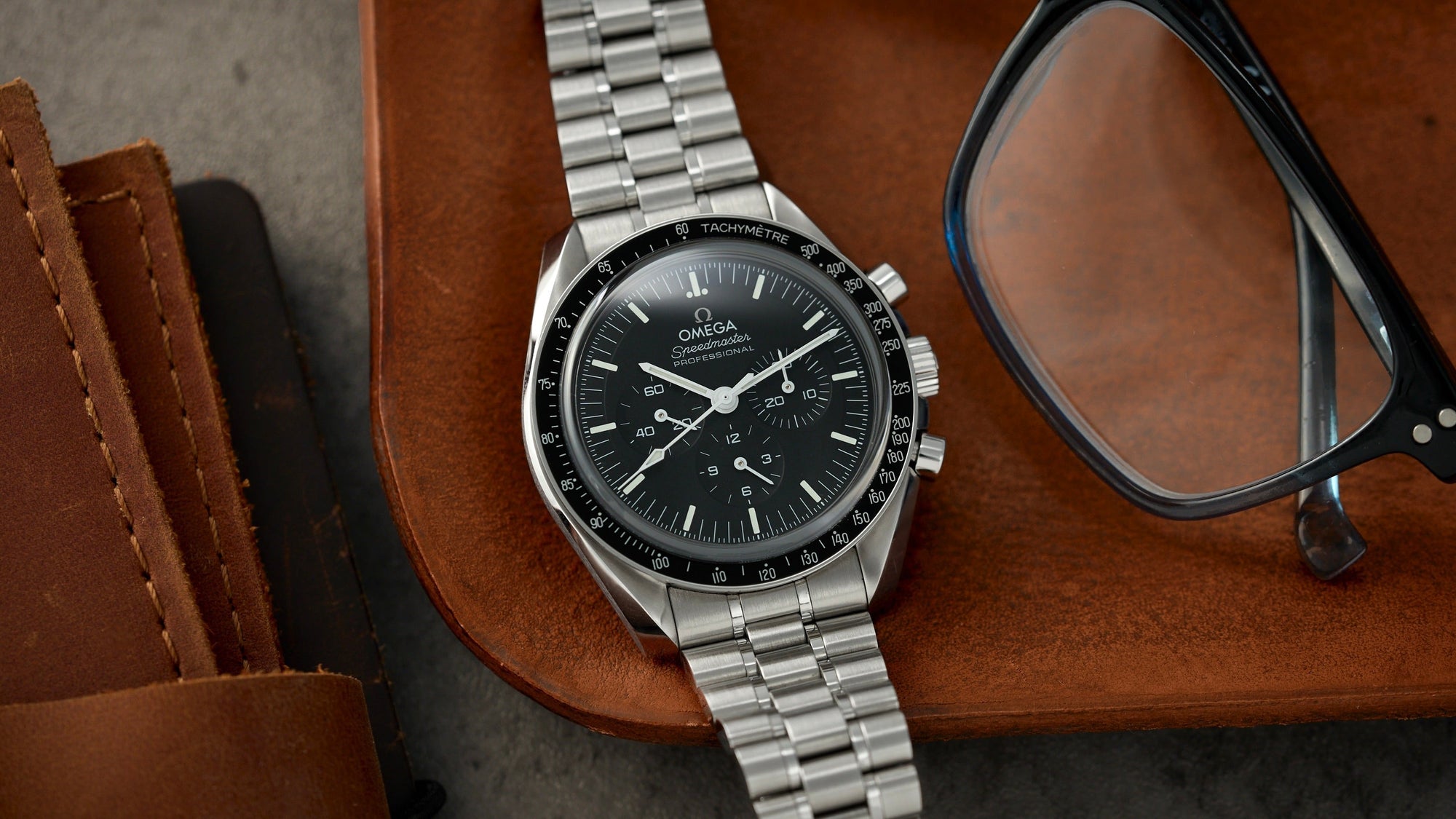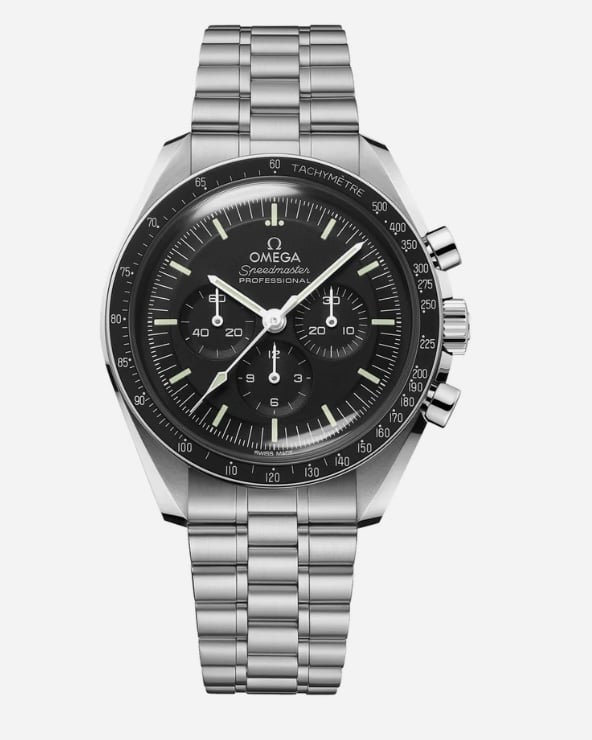And we’re back again with another episode of Affordable Alternatives to some of the most iconic watches in the game. While in previous installments, I’ve focused on watches with prices in the ridiculous range, today, I’m gunning for something a bit lower on the cost-of-entry scale, but which is nonetheless an icon of watchmaking: the Omega Speedmaster.
For Omega Speedmaster alternatives, I’m going to go the route of exploring some tricompax chronograph options that are on the extremely affordable range, highlighting some smaller, more independent brands, and also featuring some watches that have some tie-in to lunar or space exploration, given the Speedmaster’s connection to all six moon landings. As I’ve established in previous articles, some of my choices for this roundup will fall into the spot-on category, while other, quirky picks will require a little stretch of the imagination, but I will try my best to make each case.
Omega Speedmaster History

As always, it’s important to go over a little history primer of the icon before we get into some affordable alternatives. To get into the history of the Omega Speedmaster on a more in-depth, granular level, I will refer you now to this article we’ve previously published.
The story of Omega’s Speedmaster begins in 1957, several years before it became forever nicknamed the Moonwatch. In the years before the race to the moon was underway, Omega was churning out tool watches geared towards specific occupations and sports, including the dive-oriented Seamaster 300, the Railmaster aimed at scientists and engineers, and finally, the Speedmaster chronograph geared towards motorsports. The Speedmaster would begin to transcend its racing roots and venture out into the final frontier in the year 1962, when astronaut Wally Schirra wore a Speedmaster as his personal watch on the Sigma 7 mission of the Mercury program. Three years later, another astronaut, Ed White, would be the next to bring the Speedmaster into space during his historic space walk.

As the race to put a man on the moon was heating up in the early '60s, NASA contacted a total of 10 watch manufacturers to submit timepieces for consideration to be officially used by its astronauts. The timepieces underwent rigorous testing and simulations intended to mimic the wild fluctuations in temperature and pressure to gauge each watch’s mission-readiness. In 1965, the Omega Speedmaster Ref. 105.003 beat out the competition and became the first and only watch deemed “flight qualified for manned space missions by NASA.”
Of course, the Speedmaster’s reputation as the quintessential Moonwatch was forged after Ref. ST105.012 (which sported the 42mm case) made history by successfully accompanying the astronauts aboard the Apollo Mission to the moon. In the years since, an Omega Speedmaster has been included in the equipment kit that NASA supplies its astronauts with, and the Speedmaster has the glory of being the watch that has made it to the moon on all six missions.

In its modern identity, Omega has expanded the Speedmaster line to include just about any color and material construction you can imagine (including a few "Snoopy" collaboration models; the origin of those is explained here), but the Speedmaster Professional Moonwatch is inarguably the most iconic. Its contemporary identity is largely unchanged from the first model that made it to the moon, remaining 42mm and maintaining the key identifiable details, including the tachymeter scale that can be traced back to the watch’s racing roots, asymmetrical case, black step dial, and the famous "dot over 90" detail on the bezel. The current generation of the Speedmaster Professional utilizes the Omega 3861 Co-Axial Master Chronometer caliber, which has manual winding and a power reserve of 60 hours.
Bulova Lunar Pilot

It feels fitting to kick this roundup off with another chronograph that made it to the moon, albeit by accident. As the story goes, astronaut David Scott brought his Bulova chronograph along with him on the 1971 Apollo 15 mission as a personal item, though NASA had supplied the Omega Speedmaster as the official watch of space missions. When the crystal of Scott’s Speedmaster popped off, he switched it out for his own Bulova, and thus, Bulova had its very own watch with Moon-landing clout. In 2015, Bulova would revitalize this piece of history with the relaunch of its chronograph as the Lunar Pilot line.

This take on the Lunar Pilot returns to the 43.5mm dimensions of the chronograph that accidentally made it to the moon in true revival fashion. In addition to its astronautical historical ties, the Lunar Pilot is aesthetically not too far off from the Omega Speedmaster Professional, with its black dial encircled by a tachymeter scale, silver-hued indices and hands, and black tricompax chronograph dial layout. Where this watch differs from the Omega Speedmaster most obviously is in the movement department, opting for a high-precision quartz movement with the HPQ NP20. Bulova promises that this type of quartz movement packs a punch in terms of accuracy with its 262 kHz frequency, which is accurate to just a few seconds a year.
Timex Waterbury Chronograph 41mm

In my mission to find Speedmaster alternatives at the most approachable price point, I discovered that this Timex Waterbury Chronograph is one of the most affordable options, still capturing some of the Speedmaster vibe while being priced under $200.

This chronograph from Timex is, as the name suggests, part of the brand’s vintage-inspired collection that pays homage to its origins as the Waterbury Clock Company. Where I’m really drawing the connection between this watch and the Speedmaster is its black dial, paired with a tachymeter scale on the bezel, and tricompax chronograph layout, though this model opts for silver-hued subdials instead of black to color-match the dial. Other standout details that are unique to this watch are the color-matched date window that’s tucked away between four and five o’clock, the green seconds hand that has a stylized “W” on one end, and the old Waterbury Watch Company logo at 7:30. As you likely already expected from the price, this watch is quartz-powered, but as an added bonus, this piece is water resistant to 100 meters, so it does make a great candidate for a summer beater watch.
Hamilton Jazzmaster Performer Chronograph

I’m going to be honest: I'm not sure what the connection is between this chronograph and jazz (or, for that matter, between the rest of the Jazzmaster collection and jazz). Nevertheless, this black-dial iteration of the Jazzmaster Performer does come the closest to an alternative for the Omega Speedmaster in the Hamilton catalog, and for $2,445, the price is right.

This watch is a pretty no-nonsense approach to a chronograph, with its relatively clutter-free dial, and I think that this is an intentional choice by Hamilton to strike more of a versatile appeal with this piece, rather than going the explicitly sporty route. The Jazzmaster performer is 42mm (like the Speedmaster) and is water resistant to 100 meters. The biggest draw of this watch is that it is indeed powered by a mechanical movement, namely the automatic Caliber H-31.
Seiko Prospex Speedtimer Chronograph SSC819

I feel like I’ve been throwing around Seiko’s solar-powered chronograph a lot (and again, for good reason), but I’ve more so been leaning towards the white-dial models over this black one, so that feels fresh enough to me. This take on the Prospex Speedtimer chronograph is inspired by the brand’s own first chronographs that debuted in 1964, now with the convenience and accuracy of a solar quartz movement.

This model features a 39mm diameter and a sleek, blacked-out colorway that, in my opinion, feels a bit less obviously solar-powered than its model family siblings. It also, of course, makes it a more accurate alternative to the typical Omega Speedmaster Professional. Aside from its $695 price tag, the convenience of the V192 solar quartz caliber is a definite draw here, and you’ll get up to six months of power when fully charged with either natural or artificial light sources. The 100 meters of water resistance is also a huge plus.
Omega x Swatch Mission To The Moon Moonswatch

This is not intended to be rage bait, I promise, but it only feels right to include the ultimate affordable alternative to the Omega Speedmaster with the Moonswatch that started it all. Though I think the enthusiast community has drifted into Moonswatch fatigue as the initial hype has worn off, this watch was literally made by Swatch and Omega itself to capture the aesthetic of the famous Speedmaster Professional Moonwatch while opening it up to a different kind of consumer base.

The Mission To The Moon model within the extended Moonswatch universe is the closest model to the traditional Omega Moonwatch design, so I’ve gone with that here (though the Snoopy iteration is hands-down my favorite). The non-limited-edition 1965 Moonswatch models are also some of the most compelling options within the collaborative line, in my humble opinion. Just like its Omega Speedmaster counterpart, this watch measures 42mm in diameter, though the case is made in the brand’s Bioceramic material rather than stainless steel, and is quartz-powered. As we all know, the real draw of this watch is that it has all the stylistic hallmarks of the Speedmaster Moonwatch for just $270, and now, you don’t even have to brave any crazy lines outside of a Swatch boutique to get your hands on one. You can just order your own via the Swatch website as long as you have a (free) Swatch account.
Tissot PR516 Chronograph

I will be the first to admit that this isn’t the first time I’ve used this watch in an Affordable Alternatives roundup, but the mechanical Tissot PR516 more than earns its spot. It turns out that offering a mechanical chronograph at a reasonable price point remains quite the challenge, and Tissot is running the game with this one.

Of course, the similarities between this Tissot PR516 Chronograph and the Omega Moonwatch are its tricompax chronograph subdials, black dial, tachymeter scale, and overall sportiness. This watch is slightly smaller than the typical size of its Omega counterpart at 41mm, and Tissot has thrown in a bit of play with colors to break up the largely monochromatic color palette. The real winning detail of the Tissot PR516 is its manual-winding, Swiss-made mechanical movement (the Valjoux A05.291 to be exact), which can be seen through the sapphire crystal caseback, along with its under-$2,000 price tag.
Nezumi Stockholm Tonnerre

I wanted to try and add some unexpected (yet still affordable) pieces to this list, and I think this chronograph from Nezumi Stockholm fits the bill. Positioned within the independent brand’s Tonnerre collection, which is French for “thunder,” this chronograph is the most monochromatic, and similar to the Speedmaster, but if you’re not afraid of a little color, I would recommend you give the rest of the brand’s catalog a look-through (it offers a lot of fun limited editions, too, including a Pink Panther chronograph).
 Back to the watch at hand: the Tonnerre Ref. TQ2.302 opts for more unisex-friendly sizing with its 38mm diameter, and instead of a tachymeter scale, the brand has gone with a telemeter scale around the sandwich dial. I also like how the different color shading on the subdials not only adds some visual intrigue, but actually helps the chronograph functions become a bit more intuitive to read at a glance. While the $525 price tag obviously indicates that we’re working with quartz here, the movement within is the Seiko VK63 mecha-quartz movement, which combines the accuracy and ease of quartz with a mechanical module for the chronograph function; the combo gives the watch a sweeping seconds and mechanical feel when you engage the pushers. It’s kind of a best-of-both-worlds situation. I’ve gone with the bracelet with micro-adjust pairing here, but the brand does offer options on various straps at a slightly lower price point.
Back to the watch at hand: the Tonnerre Ref. TQ2.302 opts for more unisex-friendly sizing with its 38mm diameter, and instead of a tachymeter scale, the brand has gone with a telemeter scale around the sandwich dial. I also like how the different color shading on the subdials not only adds some visual intrigue, but actually helps the chronograph functions become a bit more intuitive to read at a glance. While the $525 price tag obviously indicates that we’re working with quartz here, the movement within is the Seiko VK63 mecha-quartz movement, which combines the accuracy and ease of quartz with a mechanical module for the chronograph function; the combo gives the watch a sweeping seconds and mechanical feel when you engage the pushers. It’s kind of a best-of-both-worlds situation. I’ve gone with the bracelet with micro-adjust pairing here, but the brand does offer options on various straps at a slightly lower price point.
Longines Spirit Chronograph

As you’re probably well aware, Longines has some real heaters in its contemporary catalog, and the brand as a whole is one of my initial suggestions for people looking to take a step into the entry-level luxury category of watches. As far as an alternative to the Omega Speedmaster goes from Longines, I think the brand’s black-dial Spirit Chronograph is its most worthy contender.

Unlike many other picks on my list, this one has a 42mm case size comparable to the Speedmaster. The Spirit Chronograph aesthetically leans more towards the vintage-inspired Pilot watch (whereas the Speedmaster feels more racing-oriented), which is fitting given the line’s historical connection to the aviation world. Still, the size, black dial, and tricompax layout are all the key ingredients that make this watch a good Speedy alternative. With it coming in below half the price of a Speedmaster Professional at $3,400, you’re getting a certified-chronometer, automatic movement with the COSC-certified Caliber L688.4, which is a huge draw, especially at this price point. Additionally, this watch is water resistant to 100 meters with its screw-in crown, which is another plug in terms of its ruggedness, and double that of the Speedmaster. Not too bad.
Sinn 104 ST Space Chronograph

This pick is not necessarily a 1:1 alternative to the Omega Speedmaster, but it is the German Watchmaker Sinn’s resident space chronograph. As the brand details it, the 140 St is a contemporary reimagining of the 140 S Chronograph that Reinhard Furrer wore during his interstellar stint on the 1985 D1 Spacelab Mission, so this is a piece that has astronautical history baked into its DNA.
This watch is on the larger side as compared to the Omega Speedmaster, with its 44mm diameter, and wide 22mm lugs, but I think there’s something kind of charming about this watch’s stocky build. Also, instead of a tricompax chronograph like the Speedmaster, the Sinn 140 St features two chronograph subdials at 6 and 9 o’clock with a 60-minute stopwatch function complete with a dedicated hand that measures from the dial’s center. A pilot’s bezel is situated around the dial’s interior, and there is an additional date function at the 3 o’clock position that makes the overall design feel nicely balanced. Additionally, this watch is water resistant to 100 meters, and this upgrade features Ar-Dehumidifying Technology to help keep the watch’s sapphire crystal free from fogging up with changes in humidity, temperature, and atmospheric pressure. This watch is one of the pricier alternatives to the Speedmaster, given its price tag of around $5,000, so this might be a good option for those who already have a Speedy in their collection.
Raymond Weil Freelancer Automatic Chronograph

I’m closing out this roundup with the Raymond Weil watch that is the most comparable to the aesthetic and functionality of the Speedy with the Freelancer Automatic Chronograph. I will admit that from a personal style standpoint, I am more drawn to the chronographs within the brand’s Millesime collection, which are a little more quirky, but we’re here today for Speedmaster alternatives, so I need to stay on subject. Feel free to browse around the brand’s catalog if you’re looking for something else that’s more on the unique side.

Now, getting into the specs of the watch at hand, the Freelancer Automatic Chronograph is slightly on the larger side with its 43.5mm diameter. Though this watch definitely leans into the sporty flair that you’d typically associate with chronographs, there are subtle details that make this watch feel a bit more elevated, especially given the use of different textural finishes on the dial. In addition to the snailed tricompax chronograph subdials, the outer perimeter of the dial also has that snail texture, which is an admittedly small detail that makes a big impact for me. It also reminds me of a tire, which is a fun touch for a watch with functionality rooted in the racing world. As far as the movement is concerned, this watch is powered by the automatic RW5030 chronograph caliber, which is on display through the exhibition caseback – another detail I like to see on watches at this price point, which is $4,075 to be exact.















































0 Comments